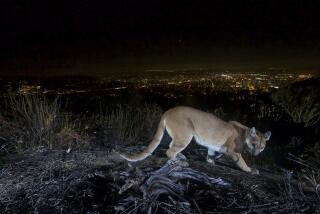George Lindsay, 85; Botanist Led Growth of S.F. Museum Complex
George Lindsay, a botanist who presided over tremendous growth at the California Academy of Sciences in San Francisco and turned its Natural History Museum into a major institution, died July 16 of congestive heart failure at his home in Tiburon. He was 85.
From 1962 to 1982, Lindsay was director of the California Academy of Sciences, the scientific and educational complex at Golden Gate Park that includes the Natural History Museum, Steinhart Aquarium and Morrison Planetarium.
It is one of the 10 largest natural history museums in the world, with collections of nearly 17 million birds, mammals, plants and other specimens. It is particularly noted for its extensive collection of specimens from the Galapagos Islands, the birthplace of Darwin’s theory of evolution and a frequent destination for Lindsay, who led museum tours all over the world.
Lindsay oversaw the construction of exhibit halls as well as the Meyer Fish Roundabout, a circular viewing area holding 100,000 gallons of water and thousands of ocean fish, and the renovation of the circa-1930s African Hall.
He resuscitated the academy’s anthropology department, which had languished for decades after most of its collections were destroyed in the 1906 San Francisco earthquake and fire. At that time, the collections were housed in downtown San Francisco.
“There are seven or eight major natural history museums. We are one of them, and he got us there,” said Bill Eschmeyer, a senior curator who was Lindsay’s director of research. “He doubled the staff here and probably doubled the square footage of our buildings.”
Lindsay’s parents were citrus farmers in Pomona, where he was born. He inherited a lemon farm and worked there and as director of a botanical garden in Phoenix before World War II led to a stint with the Army Air Force. Assigned as a combat cameraman in a unit that was led by Clark Gable and included Ronald Reagan, he helped document the war effort by filming the damage to bombing targets.
After the war, he finished his undergraduate and doctorate degrees at Stanford University, where he completed a dissertation on the barrel cactus.
From 1956 to 1963, he was director of the San Diego Natural History Museum.
He had been infatuated with cacti and succulents since discovering them during trips in his youth to the Baja peninsula.
The taxonomy of desert plants remained a lifelong interest. His home was filled with unusual specimens, including succulents from South Africa and Namibia.
He met his wife, the former Geraldine Kendrick Morris, during his early years at the academy. Under his aegis, she founded its docent program.
He is survived by five stepchildren: Charles Morris of Tiburon, Geraldine Morris of Alameda, Diana Morris of San Francisco, Austin Morris of Novato and Jane-Leslie Morris-Williams of Oakland.
More to Read
Sign up for Essential California
The most important California stories and recommendations in your inbox every morning.
You may occasionally receive promotional content from the Los Angeles Times.











